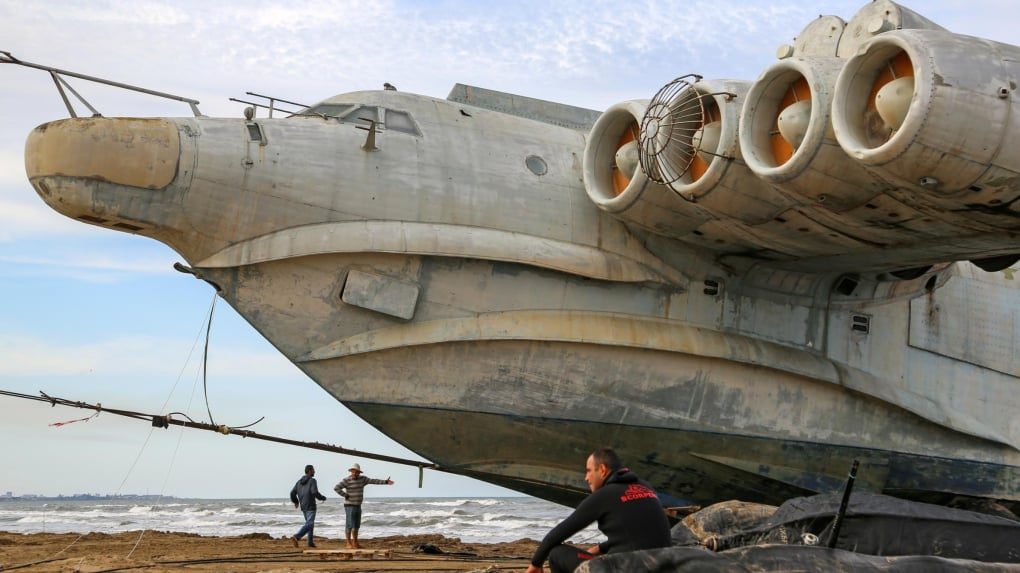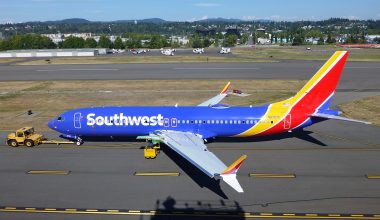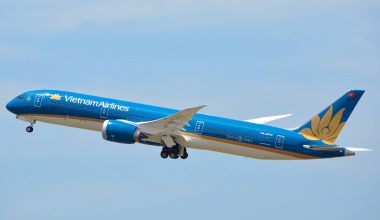During the cold war, the US and the Soviet Union competed for primacy and struggled to dominate the skies. Driven by the constant fear of being outpaced by the rival, both states contend to develop a wide range of military aircraft and weapons. The cold war was an intense period of progress in aeronautics, defense weapons, and technology for both nations. Caspian Sea Monster is one of the most impressive inventions dating back to this period.
The KM (Korabl Market), familiar as Caspian Sea Monster, was a Soviet-made experimental ground effect vehicle specialized for use by military and rescue workers. This top-secret Soviet Ekranoplan was based on ground-effect technology and designed to fly 5-10 meters above sea level at a high velocity. At its completion in 1966, it was the world’s largest aircraft, with a length of 92m and a wingspan of 37.6m.

This guide brings to the fore the formidable Soviet-era aircraft dubbed ‘Caspian Sea Monster.’
Background of Korabl Market, aka Caspian Sea Monster
Korabl Maket was a massive experimental ekranoplan designed at the Central Hydrofoil Design Bureau in the 1960s. First introduced in 1964, the aircraft was completed by June 1966 and made its maiden flight on October 16, 1966.
The KM was one of the earliest major ekranoplan projects devised by the Soviet Union that remained a secret for the next 15 years. This naval vessel was a surprise discovery for the US. In the late 1960s, as a US spy satellite hovered around the Soviet naval base, it captured images of a behemoth Soviet ekranoplan. The satellite photographs shocked Americans as the images showed a unique aircraft-having stubby, square wings and over 100m length, sitting unfinished on the coastline of the Caspian Sea.
The Central Intelligence Agency (CIA) dubbed this strange leviathan craft docked on the vast island body of water the ”Caspian Sea Monster.”
Development of the KM
During the geopolitical tension between the US and Russia, both countries were constantly alert. Both major powers raced in all major areas of defense sectors and remained on a war footing. In the 1960s, the Soviet Union saw interest in ground-effect vehicles or ekranoplans which could move at high speed over the surface but below enemy radar. These remarkable machines would usher in a new era of powerful military operations for the Soviets and give them a competitive edge.
The Central Hydrofoil Design Bureau, led by the chief designer ORstislav Alexeyev, started working on the secret development of the KM. Upon completing the KM’s functioning prototype in 1966, it was secretly transported along the Volga River to Kaspiysk. The Soviet Navy continued testing it at the Caspian Sea naval base until it was destroyed in 1980.
As a prominent developer, Rostistav Alexeyev co-piloted the first flight of the Caspian Sea Monster in 1966. It was a peculiar action since most Soviet aircraft designers never normally piloted their creations.
Design of the Caspian Sea Monster
The KM, dubbed Caspian Sea Monster, was a giant seacraft capable of accommodating 50 people with five crew. For the entirety of its existence, it held the record of the world’s heaviest and longest-flying vehicle. Its empty weight was 240,000 kg (529,109 lb), whereas the heaviest weight allowed for its pilot to attempt to take off (i.e., MTOW) was 544,000kg. This enormous ekranoplan stood 92m (301 ft 10 inches) long, and its wingspan measured 37.60m (123 ft 4 inches).
Fitted with 10 x Dobrynin VD-7 powerplants, this hybrid-boat aircraft could cruise at 430km/hour. It could travel up to 1,500km (930 mi) at a maximum speed of 500km per hour.
The KM underwent continuous testing and development on the world’s largest inland body of water-the Caspian Sea. During its testing, the KM achieved a maximum speed of 650km/hour, whereas its optimum (fuel-efficient) cruising speed was 430km/hour.
Working principle of the Caspian Sea Monster
Caspian Sea Monster was technically an aircraft but used a piece of an aerodynamic principle called the ‘ground effect’ to fly sustainably above waves. The vessel skims the water surface at the height of between one and five meters by gaining support from the reactions of the air.
Also Read: Kalinin K-7: Metal monster Russian aircraft
An ekranoplan, like the KM, flies over flatter surfaces, particularly bodies of water, without actually touching them. It moves only several meters above the water surface to reduce the lift-dependent drag. The closer the aircraft wing operates to a flat surface, the less drag it experiences due to the airflow interaction around the vehicle with the ground below. When near the ground, air cushion builds up beneath the wings, generating lift force to the aircraft.

Since ground-effect vehicles or ekranoplans are designed to glide over a level surface, the International Maritime Organization categorizes them as ships. But these vessels possess unique speed capabilities across the water to take off and fly a few meters above the surface.
Initially, the KM held promises for the Soviets as tactical equipment to get supremacy over their opposition. Its purpose-driven design was focused on holding as many troops as a ship and flying as fast as a plane while remaining undetectable to enemies’ radar systems.
The radar sensor couldn’t detect it as the KM flew near the water surface below the minimum detection altitude. Also, because it flew mere feet above the water and didn’t touch it, it was immune to sea mines, torpedoes, etc. The Soviets wanted to benefit from the KM’s speed and stealth and make it a practical transport craft.
The eventual fate of the Caspian Sea Monster
The test pilots of the Soviet Air Forces kept testing the KM on the Caspian Sea throughout its 15-year service life. But, due to its complex design, the KM couldn’t serve the purpose it was built for. Alexeyev quickly shifted his attention to other ekranoplan projects because of its limited use as a military transport vehicle. In 1980, the behemoth Sea Monster of the Caspian crashed. Because of an inexperienced pilot at the throttles, the mammoth KM prototype crashed and sank in the Caspian Sea.
Despite KM’s crash during a test flight, no human casualties were reported. The behemoth craft was damaged, but the Soviet Union left it to float on the sea’s surface. No attempts were made to save and recover the aircraft from the waters. Left abandoned, the KM sank a week later and has remained underwater at the crash site ever since.
Lun-class ekranoplan
While the Soviets never bothered building another KM, the experimental aircraft was the basis for Lun’s development. The next generation ‘Lun’ class Ekranoplan was designed by Alexeyev in 1975 and entered service in 1987.
Of the two models of this class, only one, i.e., the MD-160, was ever built to completion. The Soviet Navy Caspian Flotilla welcomed this Lun-class ekranoplan into service as an attack/transport ground effect vehicle in 1987.
MD-160, the sole completed Lun-Class ekranoplan, was made to attack submarine and aircraft carriers belonging to NATO carriers. It weighed 380 tons yet could reach speeds of up to 550km/hour. It was powered by 8 Kuznetsov NK-87 turbofans, giving it a range of 2,000km and a cruise speed of 450km/hr.
The eye-catching ‘Lun’ ekranoplan was longer than an Airbus A380 superjumbo at 73.8 meters. It stood 19.3 m tall and had a wingspan of 44m. It could carry 15 crew and a 137-ton payload. It wasn’t simply a ground-effect vehicle; it had six giant guided missile launchers at the top of its hull. Nuclear capable, the 380-ton Lun was intended to conduct lightning sea-borne attacks and destroy aircraft carriers.

The last of its breed, ‘Lun,’ fell out of favor when the once-mighty Soviet Union dissolved in the early 1990s. Following the Soviet Union’s fall, the iconic aircraft was decommissioned and left unused at Kaspiysk naval base.
The only one-of-its class ever completed MD-160 was essentially abandoned for over three decades at a naval base on the Caspian Sea. Until 2020, the aircraft was left to rust away and lie dormant on a remote military pier on the sea.
On July 31, 2020, Russian authorities pulled this legendary military aircraft from the naval base in Kaspiysk. The ekranoplan was towed ashore and moved to its destination for eventual placement in a local maritime museum.
What about the second Lun-class ekranoplan?
Two Lun-class ekranoplans were slated for production, but only MD-160 became the sole production of its kind ever completed. The second Lun-class ekranoplan, unarmed and assigned to rescue and supply missions, was partially built in the late 1980s. The construction of the second craft was underway when, in the early 1990s, the funding disappeared with the Soviet Union’s collapse. Due to the lack of military funding, the whole program was canceled, and the construction of the second Lun was halted.





